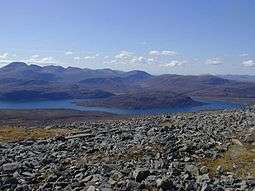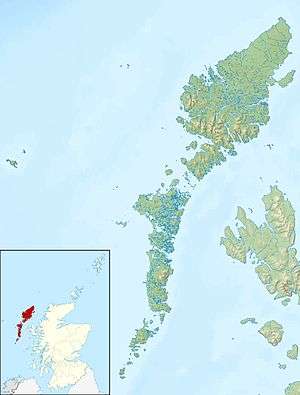Seaforth Island
Seaforth Island (Scottish Gaelic: Eilean Shìphoirt/Shìophoirt or Mulag) is an uninhabited island in the Outer Hebrides of Scotland. Unlike many other islands of the Outer Hebrides which are mainly surrounded by open sea, Seaforth Island lies in a narrow fjord-like sea loch named Loch Seaforth, 8 kilometres (5.0 mi) from the open waters of The Minch. There are two different Gaelic names for the island. Mulag is from the Old Norse name Múli, which describes its geographical location, and the other is after the family of Francis Mackenzie, 1st Baron Seaforth, who inherited the island in 1783.[4]
- There is also a Seaforth Island in the Whitsunday Islands of Queensland, Australia
| Gaelic name | Eilean Shìophoirt or Mulag |
|---|---|
| Norse name | Múli |
| Meaning of name | Norse for 'craggy ridge between fjords'; Gaelic for "island of Seaforth" |
 Loch Seaforth and Eilean Shìophoirt from the north with Clisham beyond | |
| Location | |
 Seaforth Island Seaforth Island shown within the Outer Hebrides | |
| OS grid reference | NB207111 |
| Coordinates | 58.00°N 06.7292°W |
| Physical geography | |
| Island group | Outer Hebrides |
| Area | 273 hectares (1.05 sq mi) |
| Area rank | 92 [1] |
| Highest elevation | 217 metres (712 ft) |
| Administration | |
| Sovereign state | United Kingdom |
| Country | Scotland |
| Council area | Outer Hebrides |
| Demographics | |
| Population | 0 |
| References | [2][3][4] |
| Seaforth Island | |
|---|---|
| Highest point | |
| Elevation | 217 m (712 ft) |
| Prominence | 217 m (712 ft) |
| Listing | Marilyn |
| Geography | |
| Location | Loch Seaforth between Harris and Lewis, Scotland |
| OS grid | NB207111 |
| Topo map | OS Landrangers 13, 14 |
The island has poor soil which only supports rough grazing.
History
There are no census records indicating inhabitation in the recent past, although the loch area was the subject of border disputes in the 19th century. In 1851 these were resolved by the unusual decision to allocate the whole of Seaforth Island to both counties, Ross-shire and Inverness-shire, which at the time controlled Lewis and Harris respectively.[4] This situation continued until the 1975 county reorganisation.
Gallery
 The Island from Lewis and Harris
The Island from Lewis and Harris Shore of Seaforth Island
Shore of Seaforth Island
Footnotes
- Area and population ranks: there are c. 300 islands over 20 ha in extent and 93 permanently inhabited islands were listed in the 2011 census.
- National Records of Scotland (15 August 2013). "Appendix 2: Population and households on Scotland's Inhabited Islands" (PDF). Statistical Bulletin: 2011 Census: First Results on Population and Household Estimates for Scotland Release 1C (Part Two) (PDF) (Report). SG/2013/126. Retrieved 14 August 2020.
- Ordnance Survey. OS Maps Online (Map). 1:25,000. Leisure.
- Haswell-Smith, Hamish (2004). The Scottish Islands. Edinburgh: Canongate. pp. 283–84. ISBN 978-1-84195-454-7.
